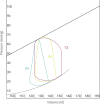Ventricular Unloading Using the ImpellaTM Device in Cardiogenic Shock
- PMID: 35402561
- PMCID: PMC8984099
- DOI: 10.3389/fcvm.2022.856870
Ventricular Unloading Using the ImpellaTM Device in Cardiogenic Shock
Abstract
Cardiogenic shock (CS) remains a leading cause of hospital death. However, the use of mechanical circulatory support has fundamentally changed CS management over the last decade and is rapidly increasing. In contrast to extracorporeal membrane oxygenation as well as counterpulsation with an intraaortic balloon pump, ventricular unloading by the Impella™ device actively reduces ventricular volume as well as pressure and augments systemic blood flow at the same time. By improving myocardial oxygen supply and enhancing systemic circulation, the Impella device potentially protects myocardium, facilitates ventricular recovery and may interrupt the shock spiral. So far, the evidence supporting the use of Impella™ in CS patients derives mostly from observational studies, and there is a need for adequate randomized trials. However, the Impella™ device appears a promising technology for management of CS patients. But a profound understanding of the device, its physiologic impact and clinical application are all important when evaluating CS patients for percutaneous circulatory support. This review provides a comprehensive overview of the percutaneous assist device Impella™. Moreover, it highlights in depth the rationale for ventricular unloading in CS and describes practical aspects to optimize care for patients requiring hemodynamic support.
Keywords: Impella; cardiogenic shock; expert group; hemodynamics; mechanical circulatory support device; review; ventricular unloading.
Copyright © 2022 Attinger-Toller, Bossard, Cioffi, Tersalvi, Madanchi, Bloch, Kobza and Cuculi.
Conflict of interest statement
MB has received speaker fees from Abbott Vascular, Abiomed, and SIS Medical. FC has received speaker and/or consultant fees from Abbott Vascular, Abiomed, Boston Scientific, and SIS Medical. RK has received institutional grants from Abbott, Biosense-Webster, Biotronik, Boston, Medtronic, SIS Medical, and consultant fees from Biosense-Webster and Biotronik. The remaining authors declare that the research was conducted in the absence of any commercial or financial relationships that could be construed as a potential conflict of interest.
Figures


References
-
- Ibanez B, James S, Agewall S, Antunes MJ, Bucciarelli-Ducci C, Bueno H, et al. . 2017 ESC Guidelines for the management of acute myocardial infarction in patients presenting with ST-segment elevation: the task force for the management of acute myocardial infarction in patients presenting with ST-segment elevation of the European society of cardiology (ESC). Eur Heart J. (2018) 39:119–77. 10.1093/eurheartj/ehx393 - DOI - PubMed
Publication types
LinkOut - more resources
Full Text Sources

